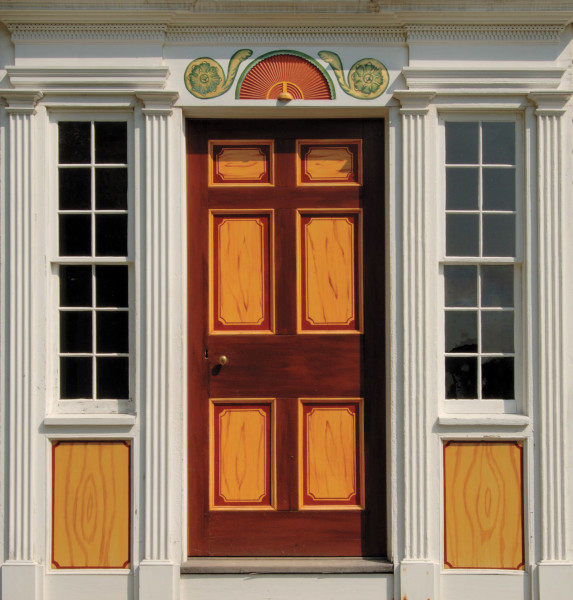Like wall stenciling, graining and marbleizing were popular decorating techniques during the 18th and 19th centuries. Recent scholarship shows that decorative and trompe-l’oeil painting were even more prevalent, diverse, and region-specific than previously known. It’s likely that any house built before the turn of the 20th century had some sort of faux painting. But it can be hard to find evidence of historic graining or marbleizing. The decorative treatment may be one of many paint layers and easy to miss; doors or trim were perhaps stripped or even replaced in the past.

This vivid, grain-painted door is surmounted by a painted fan decoration. [Jonas More House, built 1818 in Roxbury County, Delaware; relocated to the Farmers’ Museum, Cooperstown, N.Y.]
Richard Walker
Graining (wood-graining, grain-painting, faux bois) is essentially the painted imitation of an expensive wood over an inferior wood or on a plain surface. The practice changed over time, reaching a zenith in the late 19th century, when decorative painters rendered realistic versions of mahogany, quarter-sawn oak, tiger maple, or burled wood. Earlier graining was more whimsical: It was considered artistic to render curious or fantastical patterns, sometimes in colors not found in natural wood.
Marbleizing (marbling, faux marbre) means using paint and various techniques to represent marble, a decorative effect that dates back to Pompeii. More than an economical stand-in for stone, marbleizing has been a stylish put-on since the Reniassance, when it was often used in buildings whose owners could have afforded the real thing. In the U.S., marbleizing was popular throughout the 18th and 19th centuries, especially in the middle decades of the 19th century.
In Georgian, Adam/Federal, Greek Revival, and Italianate interiors, marbling was found on columns, mantels, wainscots and mopboards, staircases, floors, and even entire walls. Many examples were far from meticulous copies of real stone; instead, they were loose interpretations, if glossy and veined. Much of the Colonial-era marbleizing is simple or naïve, not fine trompe l’oeil as practiced in Europe. Color and texture were more important than deceiving the eye.
Far from our Colonial Revival concept of white plaster walls and subdued colors, the true early-19th-century interior was stunningly rich—and meant, of course, to be seen in low light.
Counterfeit Marble
A “receipt” for a black/white marbling technique from the mid-17th century: “. . . with a great Camel-hair Pencil [brush], dipt in the palest thin [light grey] Mixture, lay the finest large Clouds and Veins, which being laid on while your Work is wet, will lye soft and sweet, like that is Natural; [then] with a smaller Pencil, with a Colour one degree darker [than the first], touch all the lesser Veins and Variety of the Marble. Lastly, with a small-pointed Feather touch with the deepest Colour [dark grey], and break all your smaller Veins, making them Irregular, Wild and Confused, as in the real Stone; . . . . If neatly done, well polisht, and Varnisht, . . . [it] will in beauty and gloss equal the real Stone.”
Historian Ann Eckert Brown’s
technique for grisaille feather marbling
:
- Paint floor with ground
of light grey paint, preferably eggshell alkyd. - Apply thin medium-grey
paint using full length of a
feather, preferably a white
turkey feather, to form wide irregular drifts on the diagonal. Blend into background with
a large soft brush. - Apply a darker grey with the tip of the feather to make thin, wispy veins that move in an angular irregular way down the sides of and across the drift. Make them varying widths by moving the feather slightly
sideways on occasion as you proceed diagonally down the surface. Pounce lightly with large soft brush to soften and give
variety to the value of the vein. - Protect with several coats
of alkyd varnish.







